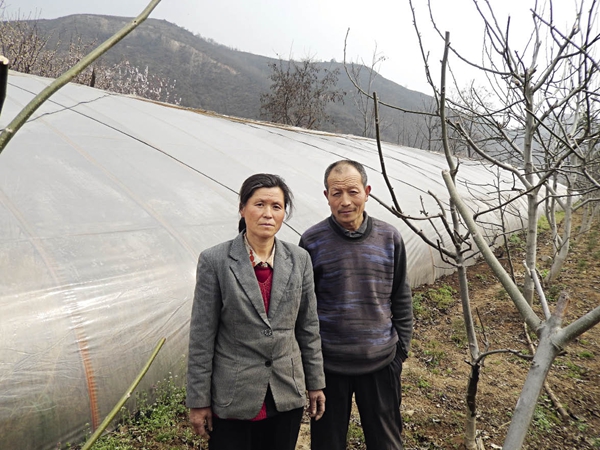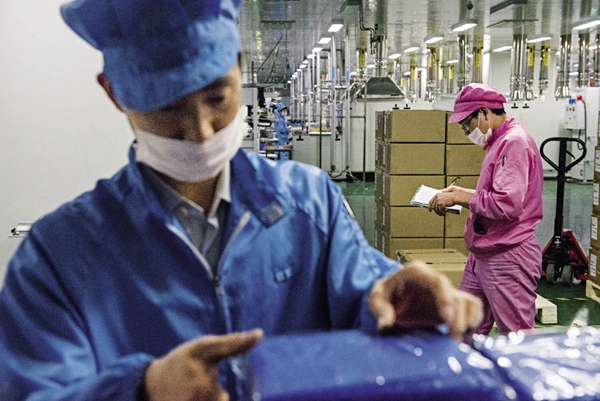Poverty Alleviation Benefits All
By staff reporter ZHOU LIN
BORN in 1966, Yu Fumin is tall, thin and looks older than his age. He and his wife live in one of the fields along the G40 Shaanxi-Shanghai Expressway. Their home is a small, dark, wooden shed, piled with sundry items, with hardly any room to stand. They grow green vegetables beside the house, and next to their greenhouse is a line of one-meter-tall walnut tree saplings. Their tiny dwelling is just 50 meters away from the noisy expressway, where trucks and other vehicles thunder past at all times of the day.
Shake off Grinding Poverty
Yu Fumin’s home is in China’s northwestern city of Shangluo in Shaanxi Province, 110 kilometers southeast of Xi’an, the provincial capital. Traveling there to Shangluo, however, takes almost two and a half hours, as the bus passes through the Daba Mountain tunnel.

Yu Fumin lives in China’s mid-western city of Shangluo in Shaanxi Province. Zhou Lin
Shangluo is located in a water conservation area midway along the south-to-north water transfer project, and is also a mineral rich area. Yet Shangluo’s economy is yet to gain ground. It is one of the country’s 14 poverty-stricken areas that constitute the nation’s one percent poorest.
As Director of the Municipal Development and Reform Commission Zhang Yongping observed, “The one urban district and six counties of Shangluo are all poverty-ridden areas. Changing this is a monumental task.”
Annihilation of poverty is one of China’s main goals over the next five years, and perceived as the biggest challenge to building a moderately well-off society in the country. It entails changing the conditions of 665 poverty-stricken counties nationwide in order to lift more than 70 million people out of poverty by 2020. For Shangluo, this means helping its 490,200 residents shake off poverty.
The village where Yu Fumin lives was formerly called Wangjian. It merged with two other rural communities of Yangyuhe Town in December 2014 to form Xieyuan Village. In addition to migrant workers employed at nearby private enterprises and other members of the so-called floating population, Xieyuan Village has 2,154 permanent residents.
At the end of 2015 the Yangyuhe Town government set up a database of poor households in the region through surveys based on the national poverty line of RMB 2,500 in annual net income, and the provincial poverty line of RMB 2,950. It identified 86 people in 44 households in Xieyuan Village that qualified for targeted relief measures.
“These families are poverty-stricken because they include disabled or chronically ill family members and those too old to find paid work, or laborers who have suffered accidents or calamities. All are in desperate need of help,” village Party secretary Yu Xuefeng said. “According to national policy, we should help them shake off poverty in three years. The Yangyuhe Town government has dispatched a three-member work team to the village to set up a timetable and put the process into motion,” he added.
As of 2015, Shangluo City had identified 701 poor villages and 161,900 poor households of 490,200 people. The second task is to provide specific assistance according to the needs of each case in various villages and different households; also to evaluate the achievements of the 885 work teams carrying out on-target poverty reduction work.
Measures to Overcome Poverty
Yu Fumin began growing greenhouse vegetables in 2000. “In earlier times, a one mu (15 mu = one hectare) field could earn about RMB 5,000 annually. But rapid urbanization made selling home-grown vegetables difficult as it wiped out sales channels. Prices fell so low that it was only worth growing enough vegetables to feed the household,” Yu said.
Yu has a family of five. He and his wife are both in poor health. Yu suffers from chronic bronchitis and a foot problem and is incapable of working in the fields. The couple must also care for his 82-year-old mother. After graduating from Xi’an University of Technology Yu’s elder son worked at a CNC machine tool factory, but since the firm went bankrupt he has been out of work. Yu’s daughter is a student of Northwest University. Although Yu Fumin does casual work that earns him an annual income of about RMB 10,000, this is far from enough to support a family of five.
Last year, with the help of village cadres, Yu Fumin planted walnut trees, and the saplings are now almost a meter tall. “These trees will bear fruit in two years. They are the hope of the whole family,” Yu Fumin’s wife said.
The work team assigned to the village is now in regular contact with employment training centers to help Yu’s son find a new job. “Yu Fumin’s family is one of the 44 households we identified as needing help to shake off poverty. We are now working out specific methods to help them, on the principle of teaching them how to fish, so feeding them for a lifetime, rather than giving them a fish and feeding them for a day,” village Party secretary Yu Xuefeng said.
The village’s poverty alleviation target is achieved through specific programs that aim to help the poor through practical measures, step-by-step. The village clerk Fang Xiushen is responsible for drafting aid applications for poor families. “Some farmers are illiterate and don’t know how to apply for aid programs. We offer them guidance according to their needs,” Fang said.
“Walnut trees, which Yu Fumin is growing, are one of the eight characteristic agricultural products that the municipal government is advocating and supporting. Shangluo’s walnuts will soon be available throughout the nation through e-commerce platforms. This will increase impoverished people’s earnings and give them a sustainable income,” he added.
During the 2016 sessions of the National People’s Congress and Chinese People’s Political Consultative Conference last March, then Governor of Shaanxi Province Lou Qinjian proposed helping the poor via the Internet technology. The Shangluo government has since accelerated the building of a logistics and distribution system. It has also pushed forward construction of an online platform from which to sell agricultural products in poor rural areas. Farmers may thus reap the benefits of convenient Internet access.
Development-driven Poverty Relief
“The absence of a mature industry through which to help poor inhabitants out of poverty is a serious problem in Shangluo, which we must address,” Zhang Yongping said. He went on to observe that the market economy breeds fierce competition that inevitably gives rise to disadvantaged groups. As poor rural households can only grow products on farmland, they cannot compete in the market, which is why they become mired in hopeless poverty.
Sixty-six-year-old Fang Zhengmin’s family is one of the most impoverished households in the village. He earns a living from selling junk and planting corn. As each kilo of corn fetches RMB 1.2, Fang earns no more than a few thousand yuan each year. Last year, his wife fell ill with myocarditis. Her medical fees amounted to RMB 40,000, which leaves the family nigh-on destitute.
“Thankfully the New Rural Cooperative Medical Care System takes care of RMB 16,000 of our medical expenses,” Fang Zhengmin said. He added that his family also receives a subsistence allowance from the government.
Fang Zhengmin has no specific work skills, and is too old for manual work. Taking into account his wife’s chronic illness, their two sons are the sole hope of this poor family. Having taught himself how to mend and maintain electrical appliances, Fang’s elder son earns around RMB 2,000 a month. With help from the government, his younger son has entered the BYD automobile industrial park in Shangluo, and also earns around RMB 2,000 a month.

Workers busy on the production line of the Shangdan Circular Industrial and Economic Park. Luo Hong
BYD Company Limited was built in the Shangdan Circular Industrial and Economic Park in 2009. It deals in solar batteries and solar power stations, automobile components and parts, and the research and development and production and sales of battery components. As the first provincial circular industrial park, BYD aims to nurture five major industrial clusters – new materials, new energy, biopharmacy, organic food, and modern services. There are now 78 enterprises in the park, two of which are among the World Top 500, and six of which are among the China Top 500.
The sight of workers in white uniforms busy on production lines greets the eye on entering the brand-new BYD factory. Next to it are dormitories and economically-priced apartments for newlyweds.
Zhang Yongping explained that poverty alleviation depends entirely on the green, harmonious and sustainable development of the local economy. Therefore, the Shangluo government gives precedence to development of the new energy and circular economy.
As one of Shangluo’s four new energy programs, the BYD battery industrial park plans to invest RMB 1.5 billion during the 13th Five-Year Plan period. Others in the park include the Yuedi electric bus production line, a Sino-German automotive industry, and a new-energy vehicle project.
The building of the Circular Industrial and Economic Park is part of the local government’s sustainable development strategy. BYD Company Limited of Shangluo, with an investment of RMB 370 million, has promoted industrial transformation and upgrading and development of the local economy, and created employment opportunities for local people.
